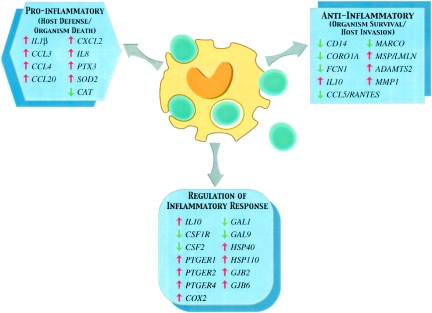FIG. 11.
Model of early gene expression of innate host defense molecules in normal human monocytes in response to conidia of A. fumigatus. The functional genomic response of normal human monocytes against A. fumigatus may fit a dichotomous model that is modulated by genes encoding immunoregulatory proteins. The dichotomous response involves genes coding for proteins mediating host defense and organism death or organism survival and host invasion. The latter may be induced by the organism or may be the result of immunomodulation causing down-regulation of host response. The third arm depicted in this model represents the complex and multifaceted immunoregulatory component of monocytes that may affect both arms of the reciprocal response elicited by the organism. The outcome of survival or death of A. fumigatus may be determined by specific host derangements that alter this finely regulated response. Results for the following genes are shown: IL1β (interleukin-1β); CCL3, CCL4, and CCL20 (C-C chemokine ligands 3, 4, and 20); CXCL2 (C-X-C chemokine ligand 2); IL8 (interleukin-8); PTX3 (pentraxin 3); SOD2 (dismutase 2); CAT (catalase); CD14 (cluster designation 14); CORO1A (coronin 1A); FCN1 (ficolin 1 precursor); IL10 (interleukin-10); CCL5/RANTES (C-C chemokine ligand 5); MARCO (macrophage receptor with collagenous structure); LMLN (leishmanolysin-like [metallopeptidase M8 family]); ADAMTS2 (desintegrin-like and metalloprotease [reprolysin type] with thrombospondin type 1 motif 2); MMP1 (matrix metalloproteinase 1); CSF1R (colony-stimulating factor receptor 1); PTGER1, PTGER2, and PTGER4 (prostaglandin E receptors 1, 2, and 4), COX2 (inducible cyclooxygenase 2); GAL1 and GAL9 (galectins 1 and 9); HSP40 and HSP110 (heat shock proteins 40 and 110 kDa); and GJB2 and GJB6 (connexins 26 and 30).

